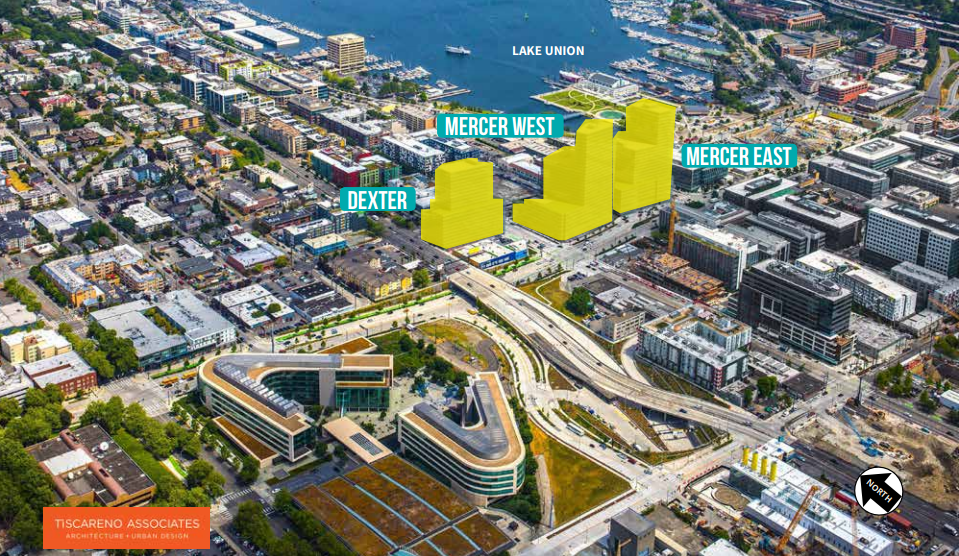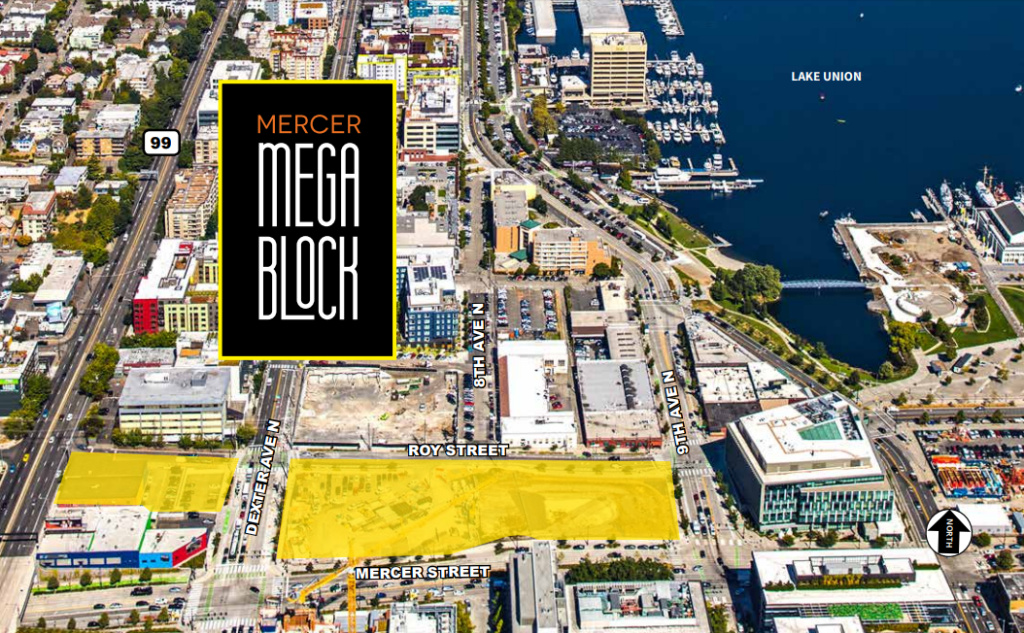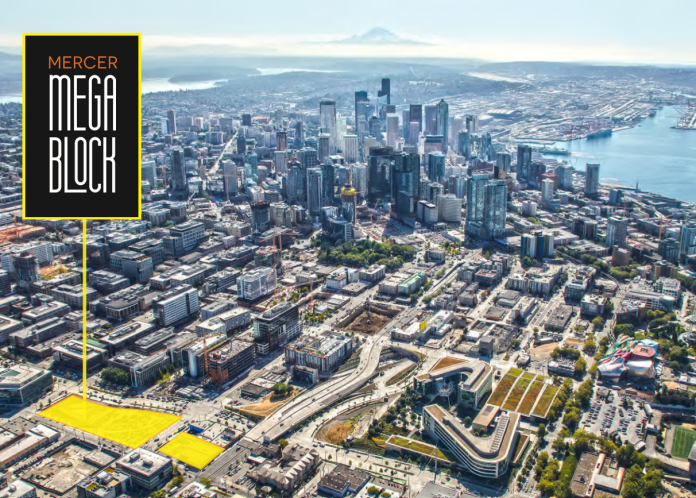On August 7th, Mayor Jenny Durkan finally unveiled the winner of the contest for the most coveted real estate parcel in town: the 2.8-acre publicly-owned Mercer Megablock site in South Lake Union. Turns out the Mayor selected a $143.5 million bid from Alexandria Real Estate, a publicly-traded real estate investment trust (REIT) specializing in biomedical campuses. The Mayor has not yet released the details of the other proposals, which included one from the Low Income Housing Institute (LIHI) and some offers built on ground leases rather than sales. (Update: Erica C. Barnett did publish the proposals on her website–with some redactions.)
A ground lease would pay dividends in the future, advocates argued, by keeping the valuable land in public hands. The Mayor ultimately decided to sell off the property to maximize the payoff. Some of that payoff is immediate since Alexandria agreed to pay $5 million of the sale price now so that the City could make an immediate boost to homelessness funding–although the City has yet to disclose exactly how that money will be used. The rest of the cash will be at closing, which is expected in early 2020.
“This is a generational opportunity for Seattle,” Mayor Durkan said in a statement. “Cities our size rarely get the chance to take an underused property we own and make bold investments to create jobs, create more affordable and mixed income housing throughout the city, and build more safe transportation connections. I believe that years from now, people will look back at this chance and say we seized an incredible opportunity to make our City better by reinvesting the proceeds directly in housing across Seattle. I look forward to working with the City Council in the coming weeks to deliver these investments in housing, jobs, great public spaces, and transportation projects across Seattle.”
The Mercer Megablock Coalition, which had pressed the City to build primarily affordable housing on the site–a site that is large enough and zoned dense enough to accommodate nearly 1,400 homes in towers up to 27 stories tall. Among those advocates is Cary Moon, who ran against Mayor Durkan and lost in the general election. (The Urbanist endorsed Moon and the Mercer Megablock Coalition effort.) Given their differing visions for public land, it appears the fate of the Mercer Megablock was sealed in the 2017 mayoral election.
“A city shouldn’t sell off publicly owned land for a quick hit of cash to backfill programs, no matter how good those programs are,” Cary Moon said in an email. “Participating in the hot real estate market in this way, instead of building permanently affordable housing to dampen hotness and provide residents relief from it, only exacerbates the problem of wealthy people (Alexandria REIT shareholders) making bank and local regular people getting pushed out. This is an example of the city as capitalist, the mayor as gentrifier-in-chief.”
Alexandria envisions the three acres becoming a “fully integrated, mixed-use life science campus,” a senior executive said–the office towers are expected to be about 16 stories tall. The proposal also includes 30,000-square-foot public community center, protected bike lane extensions, and 175 affordable-housing units. Additionally, Alexandria purchased the neighboring privately-owned half-acre Copiers Northwest site (for $28.5 million) to build housing and expand the campus. The community center will be operated by Seattle Parks and Recreation and pay no rent for 40 years.

Though it didn’t go the way the coalition wanted, the Mercer Megablock going on the market did raise awareness of the issue of underutilized public land and the need to put more land, not less in public ownership. In fact, responding to advocates, the City Council passed a new public land disposition policy last summer that made it easier for the City to give publicly-owned land to nonprofit developers, with Councilmember Teresa Mosqueda leading the way.
“Last fall, the Seattle City Council passed a resolution stating that when possible, city-owned property should be used to build affordable housing,” Josh Cohen recounted in Crosscut. “Advocates argued that using the Mercer Megablock to build thousands of units of affordable housing in the heart of the city would be a logical step in the face of Seattle’s ongoing affordable housing shortage. But Budget Director Noble said the private sale has facilitated far more housing and other public benefit at a lower cost to the city.”
“We would’ve forgone way too many things,” Noble said. “For one, we would’ve had to find revenue for building the housing, which, as we know, we have a shortage of.”
For Moon tackling the larger revenue issue is the point.
“We need long-term, sustainable revenue to build 10 times this amount of affordable housing,” Moon said. “The city needs to be developing sustainable models long term, not doing a flashy one-off deal.”

Meanwhile, Mayor Durkan advocated for sunsetting and shrinking in half the $75 million per year employee hours tax that would have greatly boosted affordable housing funding, before ultimately orchestrating the tax’s repeal behind the scenes (breaking open meeting laws in the process) after Amazon and some other major employers protested–and backed it up with hundreds of thousands in political expenditures.
The Mayor’s Office said the Mercer deal announcement is “a key component of Mayor Durkan’s ‘Housing Seattle Now’ initiative announced on July 24.” Since the funding announced so far is all one-time, it appears the Mayor’s new Housing Seattle Now campaign is focused on short-term wins rather than establishing on-going revenue to dig ourselves out of our severe affordable housing deficit like the head tax would have helped do.
How the City is Spending the $143.5 Million
As for the proceeds, the City must pay back about $29.1 million in debts incurred to buy the land (plus some borrowing against it) which was necessary to stage equipment for the Mercer Street overhaul, a $190 million megaproject, that was wrapped up in 2015, freeing up this parcel. The remain $114.4 million or so will be spent the following way with some overlapping:
- $42.2 million to buy property for developing affordable housing in neighborhoods with high risk of displacement, particularly around future light rail stations.
- $15 million (give or take) will be used as a revolving loan fund through the city’s Equitable Development Initiative to help nonprofit developers acquire land for low-income housing developments.
- $15 million for constructing affordable homes for purchase, intended for low-income residents.
- $16.7 million for bicycle, pedestrian and transit projects. This will include an eastward extension of the two-way protected bike lane on Mercer Street.
- $9.2 million will be used to offset a budget hole created by unexpectedly low commercial parking tax revenue in 2018.
- $6 million for loan program to help lower-income homeowners construct basement apartments or backyard cottages.
- $5 million homelessness funding intended for undisclosed rapid response. This portion is paid upfront.
Additionally, the City claims the project’s public benefits package is worth another $150 million or so. That figure appears to include required compensation for an Eighth Avenue alley vacation, required environmental remediation valued at $15 million, and Mandatory Housing Affordability payments of around $8 million.
A Closed Process
Another complaint critics have–beyond the contents of the deal–is how the deal was made and the process was run. We don’t know how the City chose one offer over the others, beyond assurances that this was the most lucrative for the City. The City chose to redact all details of the alternative ground lease offer Alexandria made, saying it was bowing to the developer’s wishes. Erica C. Barnett of The C Is For Crank asked the City for an unredacted copy citing transparency laws, but was denied and threatened with possible legal action.
An open process could have been a lot different.
“The possibility of listening to community, building a shared vision and commitment together, was totally wasted,” Moon said. “Say what you will about the waterfront outcome, the process was very, very good: The idea for a civic/public waterfront instead of a WSDOT highway came from the community, from grassroots imagining and pretty broad activism.”
Moon made her name leading the People’s Waterfront Coalition, which successfully blocked another SR-99 viaduct but failed to win support for their vision of a car-light waterfront with surface-level transit and park space, instead of the $4 billion car tunnel and nine-lane boulevard we ended up with.
“We had many many rounds of ‘what if’ inclusive dialog, with thousands of people helping shape the vision / values / principles before it became a formal City project,” Moon continued. “The City, once it decided to finally launch a project, already had absorbed public vision, community desire, and a much more sophisticated project scope of rebuilding urban fabric.”
The inclusive process that Moon and others have envisioned for the cities involves asking communities what they want at the beginning rather than placating them at the end of a murky process.
“The best civic projects are those that express the dreams the city has for itself. We skipped that process. By treating it like a private real estate deal, we cut out the public imagining and shared vision building,” Moon added. “Instead, we have a mayor who paternalistically wants to be the developer-in-chief, working in secret with her cronies to negotiate the best money deal, and then be the philanthropist-in-chief, handing out gifts to who she deems worth. We the people were locked out. It was the opposite of a healthy inclusive civic processes that build shared ownership and healthy engagement.”
Moon argues the City has a responsibility to facilitate collaborative planning process and get buy-in on a shared vision.
“I earnestly believe in The Right to the City. We the people have the right and the responsibility to shape how we want to live in relation to one another: what relationship to nature, how we share space across race and class, how we build healthy public life and shape containers for socializing, what sort of innovations should we reach for, how we watch out for and listen to those who are struggling, what societal wrongs can we right by this example,” Moon said. “These are the questions we need to talk through together, and it’s the city’s job to facilitate those conversations into a constructive and meaningful vision.”
Mayor Durkan’s announcement leaves many questions unanswered, details which would be useful going forward, Moon argued.
“It would be good to know more details about other alternative options,” she said. “What was LIHI’s proposal, and did it get a fair consideration? What would a ground lease option look like? How much total workforce housing will be built? Will the $5 million in homeless services be used for sweeps? Will the public space really be public, or will it feel like you are unwelcome and don’t belong on their campus?”
Not knowing how much less the ground lease offers were leaves advocates guessing; we have less to go on when planning how to handle the next juicy piece of land the City puts up for reuse.
Alexandria is likely a couple years away from breaking ground on the campus since it needs to finish its design and get it permitted and approved. “The city council is expected to approve the land deal in September,” Cohen reported.
Author’s note: An earlier version of this article incorrectly stated the City’s new land disposition policy was still under consideration. It passed in 2018.
Doug Trumm is publisher of The Urbanist. An Urbanist writer since 2015, he dreams of pedestrian streets, bus lanes, and a mass-timber building spree to end our housing crisis. He graduated from the Evans School of Public Policy and Governance at the University of Washington in 2019. He lives in Seattle's Fremont neighborhood and loves to explore the city by foot and by bike.


